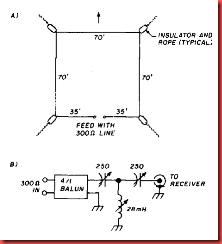The easiest way to improve your FM reception is to build an indoor FM antenna, instead of using your FM stereo’s internal FM antenna. This indoor FM antenna is easy to build, and cheap. It works every bit as good as other FM antennas that you can buy for as much as $100.
In order to build this indoor FM antenna, all you need is two 3/8” dowel rods 48” long, 10 ft. of 20 ga. wire, and some 75 ohm RG-59 or RG-6 coax (for TV’s). All of this can be picked up at your local hardware store. However sometimes hardware stores don’t have dowel rods 48”. If you can’t find any that long, you can always take two 36” dowel rods and tie them together with cable ties to the correct length.
This FM antenna is what is called a Full Wave Loop antenna. The diagram below shows the design of this indoor FM antenna:
The red is the wire, which is to be 30” on each side. The brown represents the 3/8 inch dowel rods. Also notice that the coax is fed from the side. This is not necessary, as typically full wave loops are fed from the bottom. I was interested in receiving one particular station that transmits a vertically polarized signal. Almost all FM stations transmit circularly polarized, which is both vertical, and horizontal polarization. Also feeding the Fm antenna from the side seemed to be a stronger, more reliable means of connecting the coax to the FM antenna.As far as construction of the FM antenna, the first thing to do is cut 4 inches off each dowel rod. This will then make each dowel rod 44 inches long. Next cut a slit aprox. ½ inch on each end of the dowel rods. These slits will be how you mount the wire to the dowel rods of your FM antenna.
Here is a photo of what I am talking about:
This not only shows the slot cut in the dowel rod, but also the wire, as well as the use of a cable tie to secure the wire to the end.
On the last end, where we will attach the coax to the FM antenna, put both ends of the wire into the slot leaving about an inch extending past. Next strip off the insulation and attach one end of the loop to the center conductor of the coax, and the other end of the loop to the shield of the coax.
Here is a photo of the coax being attached to the FM antenna.
Next, secure the coax to the dowel rods with it coming off the bottom dowel rod. Lastly, take a couple of cable ties and put one on the top of the vertical dowel rod to create a loop to attach a string to hang the FM antenna.
The photo below shows the completed FM antenna:
































![clip_image002[1] clip_image002[1]](https://blogger.googleusercontent.com/img/b/R29vZ2xl/AVvXsEgChoRJbtApEl_Tng_PIVP61b5fy7kQ2Zun1YjJUdAldjdtfet7NsCId7KzlPJ8opEBEKd9U-t3cEyMPvyJqlrjkFDX_RHmlFad4zNAkSag8FEIuAA9w9hBFesRDVWhEuAd5pf3uvErqEjy/?imgmax=800)
















